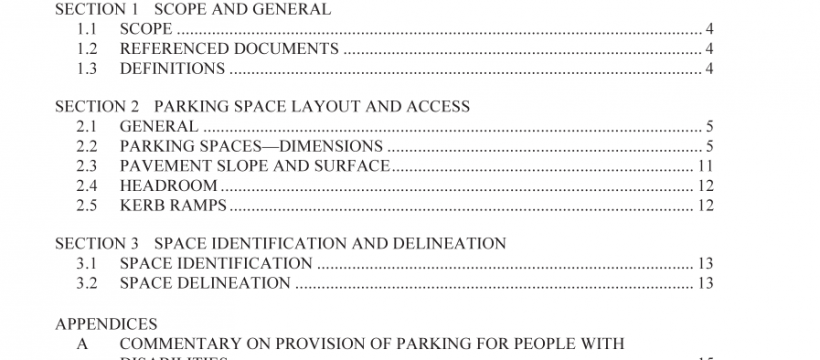AS NZS 2890.6:2009 pdf free download
AS NZS 2890.6:2009 pdf free download.Parking facilities
The shared area can be shared with any other suitable use, noting that it needs to be accessible in accordance with AS 1428.1 and free of other than transitory obstructions at all times. In a typical case, as illustrated in Figure 2.3, a 2.4 m area can be shared between two adjacent disabled user dedicated spaces. It is noted that such an arrangement can be conveniently provided in a parking configuration comprising a series of 2.4 m minimum width standard modules. Depending on which side of the vehicle the disabled user needs to alight, one or other of the vehicles may need to back into the shared area.
A similar area of length 2.4 m needs also to be provided at the end of the dedicated space for rear unloading/loading of a wheelchair. This can also be a shared area at the same level as the dedicated space. It is commonly shared with the parking aisle as illustrated in Figure 2.3.
A2.3 Parallel parking spaces
A parallel parking space will always require a dedicated space 3.2 m wide and 7.8 m long all at the one level, see Clause 2.2.2. The general case is illustrated in Figure 2.4.
The 3.2 m width needs to be entirely dedicated because a vehicle will normally have to face in one particular direction when using it and consequently will have to park hard against one edge or other of the space depending on which side the disabled user is to alight.
An extra width of at least 1.6 m is required for side ramp or platform hoist unloading and can either be shared on the traffic side with the roadway or on the non-traffic side with other usage space, e.g. a walkway. In the case of parallel parking this extra space need not be at the same level as the parking space but may be raised. Figures 2.5 and 2.6 illustrate typical layouts respectively without and with a kerb separating the dedicated space and shared area. A kerb if present needs to be not more than 190 mm high and have kerb ramps. Note that to accommodate kerb ramps the width behind the kerb may need to be increased as shown in Figure 2.6.
AS NZS 2890.6:2009 pdf free download
